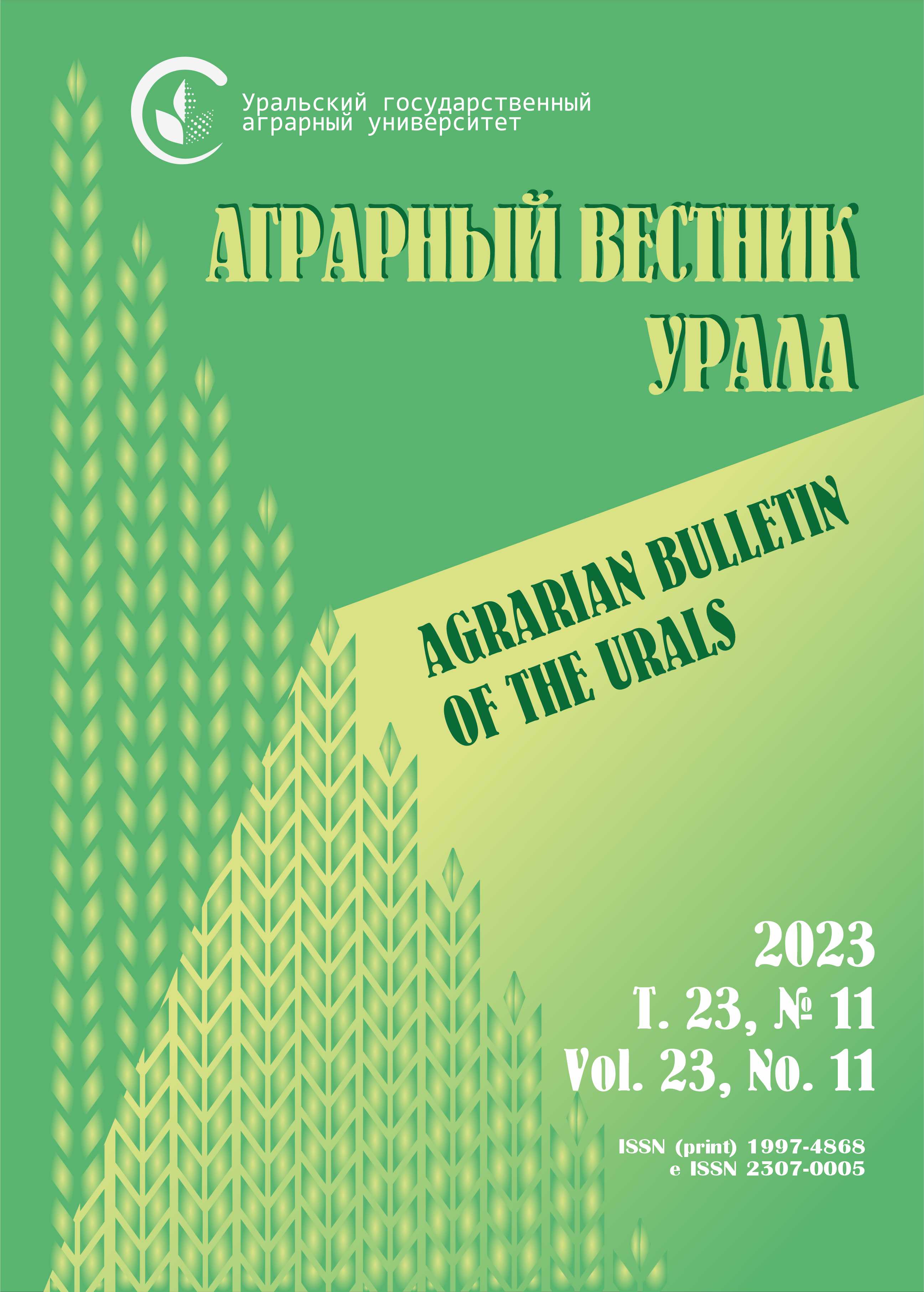Russian Federation
Russian Federation
Abstract. The purpose is to study the influence of the hepatoprotective phytocomplex on the severity of endogenous intoxication in laboratory rats with experimental liver pathology caused by hydrazine. Methods. The studies were carried out on non-linear rats, formed into 3 groups (n = 10). Toxic damage to the liver in rats of groups 1 and 2 was modeled by a single intragastric administration of hydrazine at a dose of 200 mg/kg of body weight. Immediately after intoxication and for the next three weeks in 1st group, the drug fitosomin was used – daily orally in the form of boluses at a dose of 0.5 g/kg of body weight, 2nd group after intoxication received empty cereal boluses, 3rd group was intact. In dynamics, the degree of endogenous intoxication was studied by the concentration of medium mass molecules (MMM) in the blood of animals at λ = 254 and 280 nm. Scientific novelty. Experimentally new data on the pharmacological effects of the hepatoprotective phytocomplex was obtained, which includes lecithin, dihydroquercetin, extracts of milk thistle, agrimony and golden boletus. For the first time, the effectiveness of the drug fitosomin was determined to reduce the severity of the endogenous intoxication syndrome in laboratory rats with experimental liver pathology caused by hydrazine. Results. It has been determined that hydrazine-induced liver pathology in laboratory rats is accompanied by the development of endogenous intoxication syndrome with a more pronounced increase in the blood fraction of MMM 254 relative to MMM 280. The use of fitosomin leads to a weakening of the toxic effect of hydrazine both on the liver and on the body of animals as a whole. The course application of the hepatoprotective phytocomplex increases the survival rate of rats, improves their clinical condition and leads to a decrease in the concentration of MMM in the blood. The obtained results outlined the prospects for the use of the drug fitosomin in veterinary practice in case of liver damage, as well as intoxication of animals.
rats, liver damage, hydrazine, blood, endogenous intoxication, medium mass molecules, hepatoprotective phytocomplex
1. Alehin Yu. N., Ponamarev V. S., Popova O. S. Patogeneticheskie osnovy sochetannogo primeneniya lekarstvennyh preparatov grupp gepatoprotektorov i fitosorbentov // Mezhdunarodnyy vestnik veterinarii. 2022. № 2. S. 47-52. DOI:https://doi.org/10.52419/issn2072-2419.2022.2.47. EDN: https://elibrary.ru/HXQRWN
2. Antushevich A. E., Basharin V. A., Reynyuk V. L., Bugaev P. A. Effektivnost' inozina glicil-cisteinil-glutamata dinatriya i piridoksina gidrohlorida pri ostrom otravlenii nesimmetrichnym dimetilgidrazinom // Vestnik Rossiyskoy Voenno-medicinskoy akademii. 2018. № 1 (61). S. 164-167. EDN: https://elibrary.ru/YXCBUM
3. Barsukova M. A., Dmitriev L. S., Yakubenko E. D., Homutov E. V. Optimizaciya rezhima osazhdeniya belkov pri opredelenii molekul sredney massy kak markera endogennoy intoksikacii // Universitetskaya klinika. 2021. - № 1 (38). S. 46-53. DOI:https://doi.org/10.26435/UC.V0I1(38).656. EDN: https://elibrary.ru/ZUQSOD
4. Bugaev P. A., Antushevich A. E., Reynyuk V. L., Basharin V. A. Gidrazin i ego proizvodnye: toksikologicheskaya harakteristika // Sovremennye problemy nauki i obrazovaniya. 2018. № 4. S. 31-44.
5. Vasiliadi O. I., Kuz'minova E. V., Dolgov E. P. Vliyanie fitogepatoprotektornogo kompleksa na klinicheskie simptomy i gematologicheskie pokazateli krys v usloviyah gidrazinovoy intoksikacii // Sbornik nauchnyh trudov Krasnodarskogo nauchnogo centra po zootehnii i veterinarii. 2022. T. 11. № 1. S. 263-267. DOI:https://doi.org/10.48612/sbornik-2022-1-65. EDN: https://elibrary.ru/HGAFBA
6. Vlasov A. P., Bolotskih V. A., Sheyranov N. S. [i dr.] Oksidativnyy stress i aktivizaciya fosfolipaz - faktory progressirovaniya endogennoy intoksikacii // Sovremennye problemy nauki i obrazovaniya. 2019. № 4. S. 3-12. EDN: https://elibrary.ru/HHLDQP
7. Gomzikova M. O., Malan'eva A. G., Siraeva Z. Yu. Osnovy provedeniya biomedicinskih issledovaniy na laboratornyh zhivotnyh: ucheb. Posobie. Kazan': ID «MeDDoK», 2021. 124 s.
8. Kuz'minova E. V., Abramov A. A., Koschaev A. G. [i dr.] Novye podhody k laboratornoy diagnostike sostoyaniya pecheni u krupnogo rogatogo skota // Agrarnaya nauka. 2023. № 1. S. 22-26. DOI:https://doi.org/10.32634/0869-8155-2023-366-1-22-26. EDN: https://elibrary.ru/PUEFPL
9. Pashina E. V., Zolotavina M. L. Kompleks biohimicheskih pokazateley v ocenke formirovaniya stadiy endogennoy intoksikacii v kletke // Sovremennye problemy nauki i obrazovaniya. 2019. № 6. S. 200-210. EDN: https://elibrary.ru/JATPLN
10. Solomaha A. A., Vlasov A. P., Gorbachenko V. I. Ambulatornaya diagnostika endogennoy intoksikacii v hirurgii // Ambulatornaya hirurgiya. 2022. T. 19. № 1. S. 140-145. DOI:https://doi.org/10.21518/1995-1477-2022-19-1. EDN: https://elibrary.ru/RCHSXQ
11. Kondratyuk M. O., Sorokopud O. O., Strіl’chuk L. M. et al. Chronic heart failure course prognosis depending on body weight and endogenous intoxication syndrome // Wiadomości Lekarskie. 2019. Vol. 72 (4). Pp. 527-531. EDN: https://elibrary.ru/KAOLMB
12. Mohi-Ud-Din R., Mir R. H., Sawhney G. et al. Possible Pathways of Hepatotoxicity Caused by Chemical Agents // Current drug metabolism. 2019. Vol. 20 (11). Pp. 867-879. DOI:https://doi.org/10.2174/1389200220666191105121653.
13. Nguyen H. N., Chenoweth J. A., Bebarta V. S. et al. The Toxicity, Pathophysiology, and Treatment of Acute Hydrazine Propellant Exposure: A Systematic Review // Military medicine. 2021. Vol. 186 (3-4). Pp. e319-e326. DOI:https://doi.org/10.1093/milmed/usaa429. EDN: https://elibrary.ru/TKMINJ
14. Vlasov A. P., Kamkina O. V., Trofimov V. A. et al. Metabolic Restructuring in the Liver under Conditions of Endogenous Intoxication // Bulletin of experimental biology and medicine. 2017. Vol. 163 (3). Rp. 317-320. DOI:https://doi.org/10.1007/s10517-017-3793-z. EDN: https://elibrary.ru/SIFCUB
15. Zakaria Z. A., Kamisan F. H., Omar M. H. et al. Methanol extract of Dicranopteris linearis L. leaves impedes acetaminophen-induced liver intoxication partly by enhancing the endogenous antioxidant system // BMC complementary and alternative medicine. 2017. Vol. 17 (1). R. 271-285. DOI:https://doi.org/10.1186/s12906-017-1781-5. EDN: https://elibrary.ru/EETLAC









